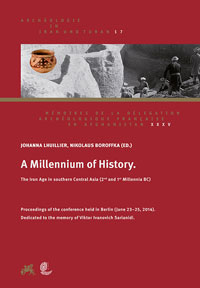
|
|
|
Große Titelansicht | Presse-Infos X u. 358 S. m. 312 Farb- u. sw-Abb., 21 x 29,7 cm, Hardcover ISBN 978-3-496-01594-9 Text in Englisch 99,00 € [D] |
|
|
A Millennium of History
The Iron Age in southern Central Asia (2nd and 1st Millennia BC)
Archäologie in Iran und Turan
Band 17
Hrsg. Johanna Lhuillier und Nikolaus Boroffka
Sofort lieferbar. Erschienen November 2018
The Iron Age of Central Asia covers 1000 years of history between the conquests of the Persian Empire and those of Alexander the Great. Social changes and the origins of the Avesta and the Zoroastrian religion, which became official in the Persian Empire, may be observed during this time.
Die Eisenzeit Zentralasiens umfasst 1000 Jahre Geschichte – von den Eroberungen des Perserreichs bis zu denjenigen Alexanders des Großen. Soziale Veränderungen und der Ursprung des Avesta sowie der zoroastrischen Religion, die im Perserreich offiziell anerkannt wurde, prägen diesen Zeitraum.
“A Millennium of History” contains new research on 1000 years of history by international scientists. The Iron Age is framed by two major cultural changes: the end of Bronze Age urban civilizations and their huge cemeteries and the conquest of Central Asia by Alexander the Great. The integration of the region into the Achaemenid Persian Empire lies at its core. Radical social changes in settlements, technology, networks and spiritual life may be connected to the roots of the Avesta and the Zoroastrian religion, which became official in the Persian Empire. A new look at texts and archaeology demonstrates full integration of Bactria and Sogdia into Achaemenid Empire during the 6th Century BC.
Der Band gibt einen umfassenden Einblick in die Eisenzeit im südlichen Zentralasien, deren Anfang und Ende durch zwei wesentliche kulturelle Veränderungen markiert werden: das Ende der bronzezeitlichen urbanen Gesellschaften mit ihren großen Gräberfeldern sowie die Eroberung Zentralasiens durch Alexander den Großen. Zentral ist dabei Eingliederung dieser Region in das achämenidisch-persische Reich. Tiefgreifende soziale Veränderungen in der Besiedlung, der Technologie und im spirituellen Leben lassen sich mit dem Aufkommen des Avesta und der zoroastrischen Religion verbinden, die zur offiziellen Religion des Perserreichs wurde. Ein neuer Blick auf Texte und archäologische Forschung demonstriert die vollständige Eingliederung Baktriens und Sogdiens in das Achämenidenreich während des 6. Jahrhunderts v. Chr.
The Editors:
Johanna Lhuillier is presently a researcher at the Maison de l´Orient et de la Mediterranee in Lyon. In recognition of her work on the Iron Age of Central Asia she has been awarded scholarships by the Fondation Fyssen (Paris) and the Alexander von Humboldt-Stiftung (Bonn).
Nikolaus Boroffka is presently senior researcher at the Eurasien-Abteilung des Deutschen Archäologischen Instituts. He has worked on the Bronze and Iron Ages of Central Asia for several decades, with special focus on ancient settlement dynamics and environmental and resource management.
Schlagworte Internet
Central Asia, Iron Age, Achaemenids, Avesta, Zoroastrians, Pottery, Architecture, Religion, Persian Empire, Burials, Ancienttexts, Zentralasien, Eisenzeit, Achämeniden, Avesta, Zoroastrier, Keramik, Architektur, Religion, Perserreich, Begräbnisse, alte Texte
Das KÖNNTE SIE AUCH INTERESSIEREN |

